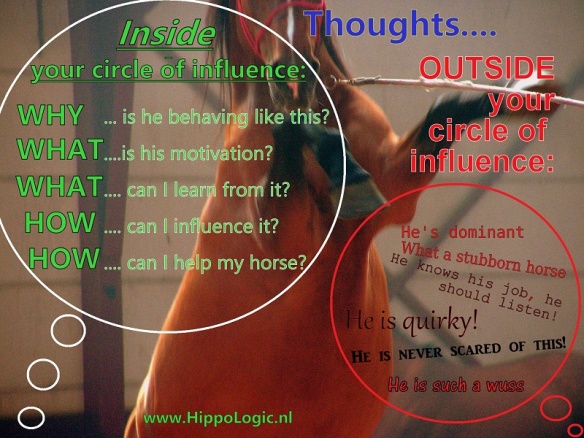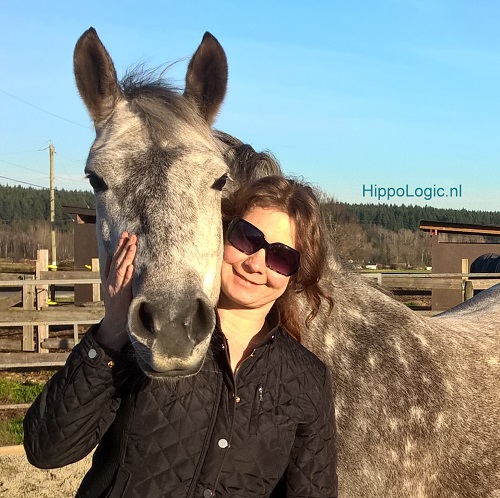We all know this scenario. There is something new in the arena, but only the third or maybe the fourth time you ride past it, your horse spooks. “What a poseur,” you think.”He just walked past it several times!” What is going on here?
If you know it, the next question is: Do you know what to do about it? In animal training we call it ‘trigger stacking’. That is what this blog is about.
What is Trigger Stacking?
Trigger stacking is when too many stimuli occur in a short period of time that the horse can’t coop with. In other words: tension builds up. If you can’t recognize triggers and trigger stacking your horse can go over threshold.
When your horse goes ‘over threshold’
When we talk about a threshold in animal training we talk about ‘a level at which the animal goes into another emotional state which causes a negative (undesired) reaction.’
 If your horse goes ‘over threshold’ due to trigger stacking it means the horse can’t coop with the stimuli (the unfamiliar or new thing in the arena, the fact that he can’t investigate, that he is forced to approach it and so on) and he goes into flight (sometimes fight) response in order to release the tension.
If your horse goes ‘over threshold’ due to trigger stacking it means the horse can’t coop with the stimuli (the unfamiliar or new thing in the arena, the fact that he can’t investigate, that he is forced to approach it and so on) and he goes into flight (sometimes fight) response in order to release the tension.
That is why the horse doesn’t spook the first time, but only after he has to approach the scary thing several times in a short period of time without releasing the tension that the anxiety causes.
How to keep your horse under threshold
Make sure you read your horse. Get rid of the myths that prevent you from being creative. I am talking about the “He is a poseur” or “He is out there to get me” statements. Those statements don’t help you find solutions, they keep you stuck (the “It’s the horses’ fault”- attitude).
I help my students keeping an open mind and treat everything the horse does as ‘information’. Is he getting tense going near that new flower pot in the arena? Is he hesitating to go past it? Did he slow down a bit? That is your information! That could be a trigger.
Pay attention to your horse and to everything he does. Even the ordinary things like pinning his ears when being saddled. Something like that could be the first trigger already.
If you feel your horse is tense about something, make sure you pay attention and let him know you care by letting him look and investigate. Or move away to a safer distance if that is what he needs. Don’t force him to stay and investigate. That will only increase the triggers that are already stacking.
Doesn’t that take a lot of time?
Giving your horse the opportunity to take a look at scary things, even though he has seen already hundreds of flower pots is only the first step in ‘despooking training’. The next step is reinforce walking by scary things, but before you are ready to do so, your horse needs to know he can trust you first.
You do that by giving him the time to explore on his own terms. Not giving him 3 seconds and “now you’re done” because 3 seconds seems enough to you. Let the horse explore for as long as he needs to decide it is safe. It can take up until 15 seconds (in the second video it takes 20 seconds for Kyra). Believe me that everything after counting slowly to 5 already feels like eternity!
Try it out, it will change your training and the relationship with your horse. Kyra almost never needs more than 8 seconds. Then she is done, tension is released and I know that keeps us both safe.
In this video, with the horse ball she needs 24 seconds (0:49-1:13) to decide she wants to approach me, standing near the ball. After the session in the videos she was never afraid of the ball again. Where other horses kept spooking because the ball had moved to another corner, Kyra was OK where ever the ball was of whomever was playing with it. Well worth my few minutes of training.
More ways to keep your horse under threshold
Another way to keep your horse under threshold is to do exercises that make him calm or offer exercises that release tension from his body.
Calming exercises are things that has been positively been reinforced in the past like touching a target or mat training.
In some situations you can calm your horse by exercise so if they can ‘walk it off’, in some situations movement increases the adrenaline. Watch the video again and see what Kyra needs.
Sometimes you need to dismount in order to break that negative spiral of trigger stacking and tension building up. That is OK, because you are doing the sane thing, which is the safe thing. When you and your horse are calm you can mount again. You might only have to do this once or twice before you find other ways to deal with it under saddle.
This blog doesn’t have enough room to tell you everything I know about trigger stacking, preventing it and dealing with it. Do you want to learn more about ‘Emotions in Training’ and how to coop with them? Join HippoLogic’s online course Ultimate Horse Training Formula. In this course is a whole module about Emotions in Training. Not only equine emotions and how you can recognize them, but also human emotions, like dealing with frustration, feeling like a failure, fear and more.
Here is another blog about it.
Please share the love
If you want to share this on your own social media, that’s awesome! Use one of the share buttons below. I also love to hear your view on this subject, so please add a comment. I read them all!
If you don’t know what to say simply hit the like button so I know you appreciated this blog. Thank you!
PS Do you know about my membership program?
Happy Horse training!



 Sandra Poppema, B.Sc.
Sandra Poppema, B.Sc.
You must be logged in to post a comment.